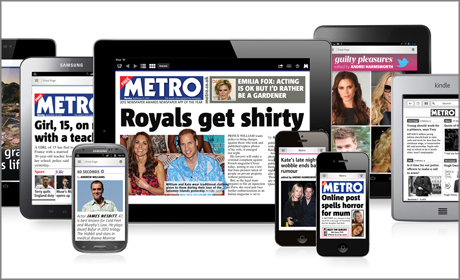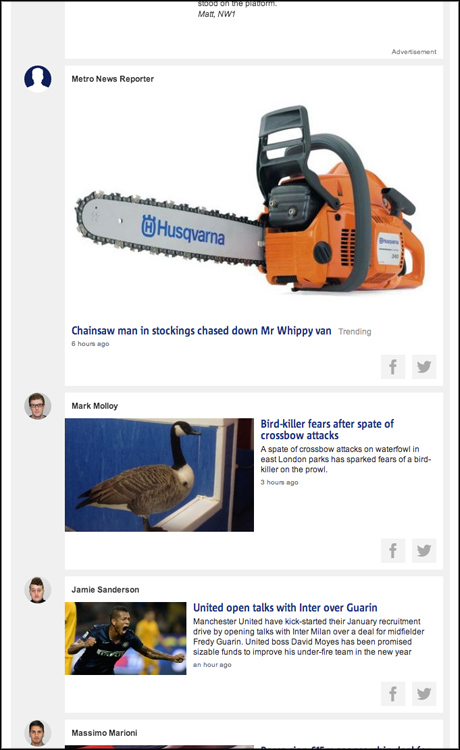

Metro is integrating a social media-style newsfeed of content into its site as part of a commitment to social, mobile-first ideas in the organisation's broader digital strategy.
The stream of content was introduced quietly as a timeline at the bottom of the homepage in the summer but has been given an increasingly prominent role due to increased interaction from readers.
"I have a general long-term theory that everything is moving towards streams of content," David Jensen, head of development at Metro, told Journalism.co.uk. "Little streams of content like Facebook or Twitter – that kind of a paradigm is going to become much more common."
In its current guise, the newsfeed is featured on the homepage and at the end of individual articles, but it will soon extend to the different "channels", or topic sections, and be moved to a higher position on the homepage.
The articles are sorted by an in-house algorithm on the homepage, said Jensen, based on a mixture of topic, timeliness, popularity and editorial importance, interspersed with native advertising, and with stories appearing as a "card interface" with different size images depending on the nature of the story.
"The information architecture, i.e. how big the image is, denotes how important the story is, rather than too many labels like 'trending' or 'popular' or all that," Jensen said. "I want the content to sing and hopefully we can build a user experience and information architecture which tells you that without screaming it.
"A lot of people like to scream at you and I like it quite clean and simple. Hopefully that's what is coming across."

Screenshot from Metro.co.uk, showing the the three image sizes
Making news social
The design and appearance of the newsfeed – on mobile in particular – bears intentional similarities to social networks, with an infinitely scrollable stream and obvious buttons for sharing articles.
"We're going down the general idea that the site is made to share," Jensen said, "and to make us feel unique and different – to make us look like a social network – seemed like a natural evolution from where we were."
Martin Ashplant, Metro's head of digital content, has been working with Jensen in taking the lead from social media on how news is presented, instead of just using social networks for distribution.
"People are increasingly used to seeing content in constant streams on mobile and we're looking to give people something to dip in and out of," Ashplant told Journalism.co.uk, as Metro also reported UK mobile traffic of 52 per cent in November, and an increase of 24 per cent month-on-month in unique browsers for the site as a whole, reaching 20 million unique viewers.
The potential popularity of a story on social media has played an important role in this growth, he said, and also in how writers and editors frame the story before publication.
"We have content called 'stories worth sharing'," Ashplant said, "and it's very much about asking the question if this is something that my Facebook friends would share, or people would talk about in the pub, or you'd tell your wife. If not, how do we make it more like that?"
In this respect, the newsfeed is the latest example of the same approach, Ashplant said, in showing readers what they want to read while "tinkering and tweaking" to get it right.
Lean principles
Jensen launched the newsfeed without fanfare at the end of the summer, slowly building on a basic iteration and letting readers find and respond to it naturally.The only way that you can learn from things is in getting them live soonerDavid Jensen, head of development, Metro
The first draft of the newsfeed was a "pretty basic" timeline on the homepage, he said, but even though it was situated below the fold it still received a lot of interaction.
The continued popularity of the feature among readers led to Jensen adding images, author bylines and photos, the algorithm and adverts in separate iterations as the "experiment" continued.
"The only way that you can learn from things is in getting them live sooner," Jensen said, "and then seeing what the feedback is from them and tweaking them.
"That's why we've put them at the bottom [of the page]. Down the bottom of every article on the homepage is a nice place to experiment without anyone getting really shirty over small changes that we still need to make."
At present, only the homepage uses the algorithm, whereas article pages have a time-based feed for that particular channel, and channel home pages do not have a newsfeed at all.
In the coming weeks however, Metro intends to roll the newsfeed out to different parts of the site and give it a more prominent position on the home page, all while monitoring how readers respond and what elements prove to be the most popular.
Eventually, said Jensen, the site will become more data-driven and elements of personalisation could be introduced based on information stored locally by browser.
Supporting statistics
Measuring what is or is not working with new features on a site can only be made in a live context, said Jensen, because they need to be integrated with the content and have real users and readers respond. And when the behaviour of visitors to websites can be logged and monitored so closely, it provides real data to justify the decision-making process.We track every click on the site and look at that in quite a detailed way after we release things to see what works and doesn'tDavid Jensen, head of development, Metro
The swipeable web editions introduced in February were phased out in November, Jensen said, as they complicated the site's architecture while not making enough of a difference to how much people were using the site.
The newsfeed, however, has already seen a response.
"As we have increased the image sizes based on the popularity of the content and editorial settings we have roughly doubled the amount of people clicking on the images from around 2,000 to 4,000 a day," Jensen said, with between 15,000 and 20,000 people clicking on titles on the timeline each day.
The effects of the algorithm in surfacing more popular content is positive as well, he said, despite only being available for a few days.
When the wide-ranging changes to the site and digital strategy were first announced in late 2012, the importance of a social element and mobile-first design were emphasised in being the drivers for change, and the long-term statistics are supporting that.
Alongside figures from the Audit Bureau of Circulation (above) mobile traffic has increased by 277 per cent year-on-year, while social referrals have increased by over 1,000 percent since the start of the year.
Tweet from Richard Moynihan, social media and community manager, MetroSeeing similar here. Visits from social to http://t.co/K7iPtlxbHI in Nov up 10.9x since Jan; social UVs up 2x frm Oct http://t.co/dytwGEvW4g
— Richard Moynihan (@richjm) December 2, 2013
"It's this journey that we've been on around making better decisions around data," Jensen said. "We track every click on the site and look at that in quite a detailed way after we release things to see what works and doesn't."
By building on ideas that have made the Metro site more social and mobile-friendly, the users are now driving the make-up of the homepage rather than the other way round, he said, and in so doing making it more relevant to their own tastes. It is still an experiment, but it is only through such experiments that Metro can understand how to take the site forward.
"By trying lots of things you get much better at figuring out what works and what doesn't and then over time you get to a point and have moments when you see what seems like the right thing," explained Jensen of the broader strategy.
"Then you can back that up with data and build a narrative or story around that which will engage with the wider business."
Update: This article has been updated to show the plans for personalisation will be based on information stored locally by browser rather than holding an account with Metro.
Free daily newsletter
If you like our news and feature articles, you can sign up to receive our free daily (Mon-Fri) email newsletter (mobile friendly).
Related articles
- Journalists are happy to be disconnecting from platforms, should news organisations be worried?
- Protecting journalists on social media, with Valérie Bélair-Gagnon
- 10 creative ways to interview celebrities and experts
- 200 speakers you need at your next journalism event to avoid all-male panels
- What will your audience want in the future?









